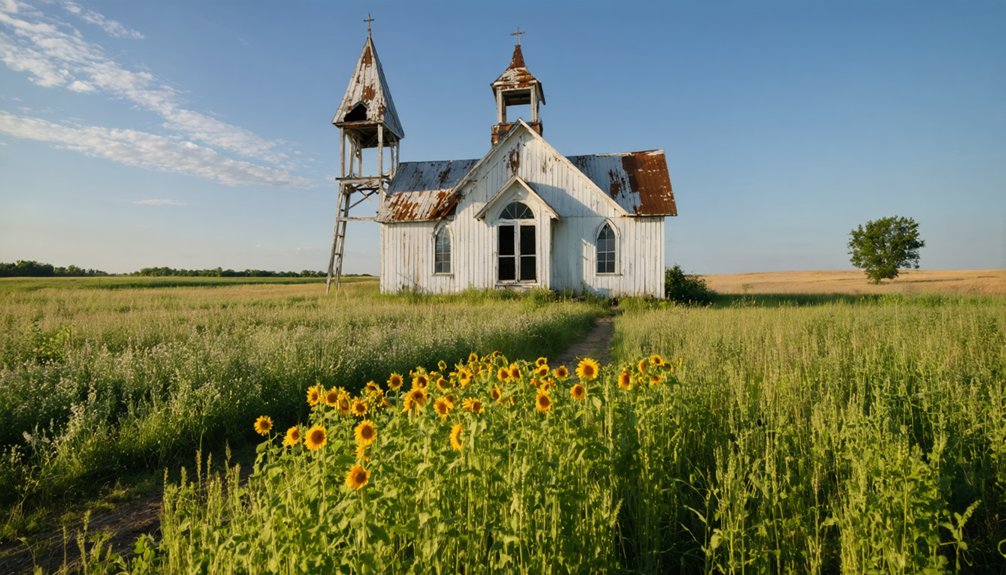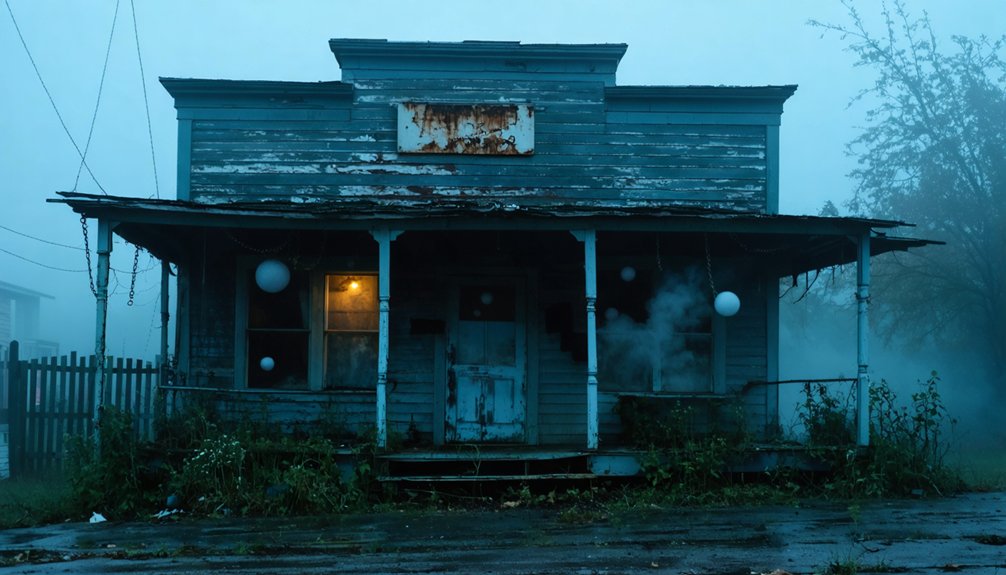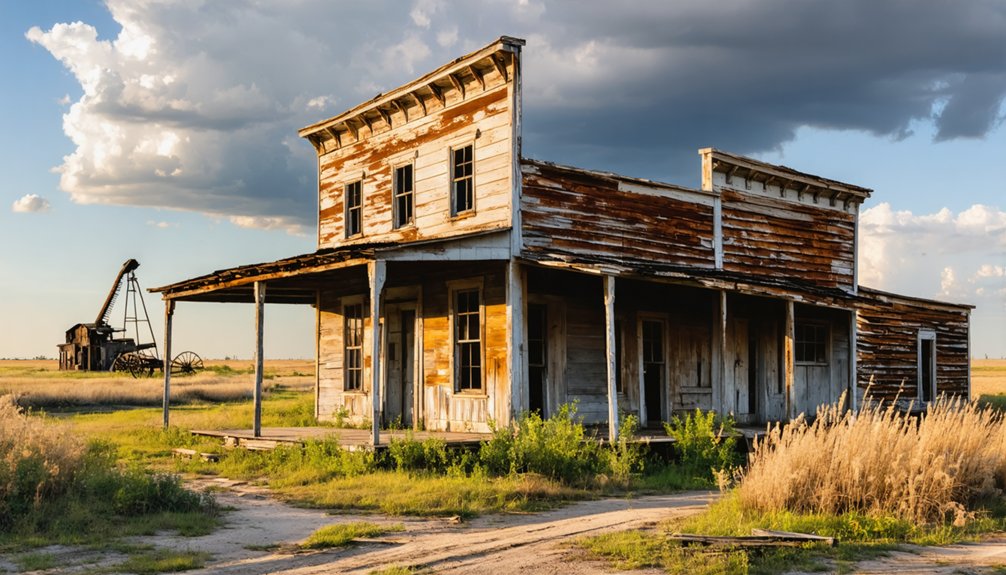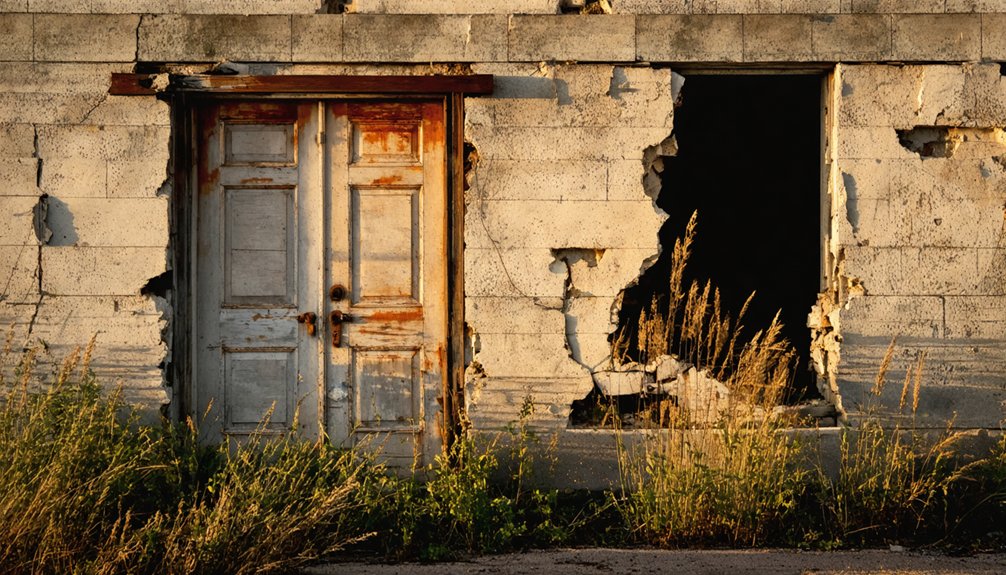You’ll find Newport’s haunting remains along the Trinity River, where German settlers built an essential trading post in 1846. This bustling river port handled cotton shipments and served as a lifeline for isolated homesteads until floods and missed rail connections spelled its doom. Today, its forgotten cemeteries and crumbling foundations tell stories of immigrant dreams, community resilience, and the ghostly echoes of Texas’ pioneering spirit.
Key Takeaways
- Newport declined from a bustling river port to a ghost town after being bypassed by major rail lines in the late 1800s.
- The town’s economy collapsed when shipping routes changed, causing businesses to close and residents to relocate elsewhere.
- Natural challenges like floods and poor soil quality contributed to Newport’s abandonment and eventual ghost town status.
- Originally established in 1846 by Joseph Werner, Newport once thrived as a German settlement and important Trinity River trading post.
- Only remnants of buildings and Black Hope Cemetery remain as physical evidence of Newport’s former existence as a community.
A German Settler’s Vision Along the Trinity River
The German settlers who ventured to Texas in the mid-1800s carried grand visions of creating their own prosperous communities along the Trinity River.
You’d find these hardy folks, mostly from regions like Hanover and Brunswick, drawn to the promise of fertile soil and abundant water. They’d escaped religious persecution and economic hardship back home, dreaming of building self-sufficient settlements that’d showcase their cultural preservation through Lutheran churches, dance halls, and traditional biergartens.
These pioneers brought agricultural innovations to the Texas frontier, planning advanced irrigation systems and scientific farming methods. They diversified their crops beyond the typical corn and cotton, growing unique vegetables like nine-pin bowling. By 1850, they had established a distinctive German Belt settlement stretching from Galveston to Kerrville.
Despite deadly challenges from disease and harsh conditions, they remained determined to establish thriving farms on their 320-acre land grants. They envisioned a “boundless sea of green” where German traditions could flourish alongside American freedom.
The Rise of a River Trading Post
You’ll find Newport’s early growth closely tied to its strategic position along the Trinity River, where German settlers first recognized its potential as an essential trading hub.
The settlement quickly established itself as a bustling river port, with merchants setting up shop to handle cotton shipments and trade goods moving between inland farms and coastal markets. Trade flourished as steamships increased commerce along the waterways.
As steamboats regularly docked at Newport’s landing, you’d have seen a steady stream of traders exchanging everything from farm equipment to household necessities with both settlers and Native Americans who frequented the post. Similar to the Kalispel Indians who had inhabited the area for approximately 10,000 years, early traders recognized the location’s natural advantages for commerce and settlement.
Trinity River Trade Hub
Along the winding Trinity River, Newport emerged as one of several bustling trade outposts during Texas’ early republic years, joining the ranks of established river ports like Liberty and Cincinnati.
You’d find steamboats churning up and down these essential trade routes by 1844, replacing the slower packet boats that had served the region since 1836.
Newport’s landing became a lifeline for local settlers, where you could catch sight of cotton bales piled high, awaiting transport to Galveston’s international markets.
The river commerce didn’t stop there – meat products, hides, beeswax, and timber all flowed through Newport’s busy port.
Like its sister settlements dotting the Trinity’s banks, Newport played a significant role in transforming the river into Texas’ commercial backbone, connecting inland farmers and merchants to the wider world.
The Trinity River served as a commerce superhighway that sustained the growth of numerous riverside communities through the mid-1800s.
Steamships like the Mary Conley and Scioto Belle regularly docked at Newport’s wharves, maintaining vital passenger and mail routes for the region.
German Settlement Origins
While Newport’s riverside commerce flourished, German settlers brought a distinct cultural dimension to the trading post’s development in the mid-1840s. These pioneers were part of the massive German migration organized by the Adelsverein, which promised 320 acres and various supplies to each family seeking freedom from their homeland’s oppression.
Y’all wouldn’t believe the settlement challenges these folks faced – disease, starvation, and harsh conditions claimed many lives as they pushed inland. The settlers built a dozen houses as they established their new village on the peninsula.
But their community resilience shone through as they established schools, farms, and social institutions. Their cultural contributions transformed Newport’s character, introducing German language education, lively music traditions, and that warm sense of Gemütlichkeit that defined their social gatherings. The settlers also established breweries and biergartens as cherished social gathering spaces.
Despite the Adelsverein’s financial troubles, these determined settlers laid down roots that would shape Texas culture for generations.
Early Commerce Development
Before the iron horse thundered across Texas, Newport’s strategic location on the river made it a bustling hub of commerce in the 1830s.
You’d find steamboats maneuvering the treacherous waters, dodging sandbars and snags while hauling cotton and supplies to coastal markets. The trading post served as a lifeline for settlers, connecting isolated homesteads to essential trade networks. Similar to other communities across Texas, Newport’s development depended heavily on community contributions from local merchants and farmers.
The town’s river routes opened up opportunities for local farmers and merchants, though Mother Nature didn’t always cooperate. Much like Newport, Rhode Island’s 150 separate wharves in colonial times, the Texas town’s waterfront buzzed with maritime activity.
When floods swelled the riverbanks, commerce ground to a halt. Still, Newport’s trading post thrived, anchored by a post office that kept folks connected to the outside world.
That is, until the railroad changed everything, offering faster, more reliable ways to move goods across the Texas frontier.
Life in Early Newport Settlement
You’d find life in early Newport bustling with activity as Trinity River trade brought prosperity to the settlement, attracting merchant vessels and creating opportunities for local families.
German immigrants like Joseph Werner joined other pioneer settlers to establish a tight-knit community, sharing resources and helping each other navigate the challenges of frontier life.
The daily struggles of clearing land, building homes, and maintaining river access tested the settlers’ resolve, but the promise of prosperity through river commerce kept them persevering.
River Trade Fuels Growth
The lifeblood of Newport’s early prosperity flowed along the Trinity River, which served as the settlement’s economic backbone after its founding in 1846. You’d have seen steamboats laden with cotton and lumber making their way downstream, while manufactured goods from distant markets journeyed upstream to enthusiastic merchants and settlers. This river commerce transformed Newport from a modest landing into a bustling port town.
The waterway’s impact on economic sustainability couldn’t be overstated. You’d have found merchants’ warehouses dotting the riverfront, while blacksmiths, innkeepers, and traders set up shop nearby.
The docks hummed with laborers loading cargo, boat crews swapping tales, and traders striking deals. When steamboats arrived, the whole town came alive with festivals and market days, creating a vibrant community where river-based opportunities shaped daily life.
Immigrant Families Build Community
When German emigrant Joseph Werner founded Newport in 1846, he set in motion a remarkable blend of immigrant cultures that would shape the settlement’s character.
You’d find German scholars mixing with Irish Catholics and Quakers, creating a vibrant tapestry of languages, faiths, and customs. Immigrant cooperation became the bedrock of Newport’s early survival, as families banded together to tackle frontier challenges.
Here’s what defined Newport’s communal resilience:
- Settlers built each other’s homes and barns, sharing labor and resources.
- Diverse religious groups practiced tolerance, fostering unity despite differences.
- Families adapted European farming techniques to Texas soil while maintaining cultural traditions.
Together, these immigrant families forged bonds that transcended their origins, building a community where freedom of religion and mutual support flourished despite frontier hardships.
Daily Pioneer Challenges
Living in early Newport demanded extraordinary grit from pioneers who faced relentless environmental and social challenges.
You’d wake to flooded homesteads near the White River bend, fighting mosquitoes while tending crops in brutal summer heat. Pioneer resilience showed in how folks tackled poor soil with backbreaking labor, just to put food on the table.
Without modern conveniences, you’d haul water from questionable sources, battle winter’s chill in barely insulated homes, and trek miles on muddy roads for basic supplies.
Communal support became your lifeline – neighbors helping neighbors survive through informal networks and shared labor. When illness struck, you’d rely on home remedies and midwives, as proper medical care was scarce.
Despite these hardships, the community’s determined spirit kept Newport going, one challenging day at a time.
Transportation’s Impact on Town Survival
Transportation infrastructure proved decisive in Newport’s fate, as it did for countless Texas ghost towns during the early 1900s.
As transportation evolution reshaped the Texas landscape, Newport’s inability to secure significant rail connections spelled trouble for its economic survival. The economic shifts that followed left the town struggling to maintain its commercial foothold in an increasingly connected region.
You’ll find these three key factors sealed Newport’s destiny:
- The railroad’s bypass of Newport meant losing essential shipping access for local agriculture and livestock.
- When major roadways redirected traffic elsewhere, the town lost critical through-traffic that once sustained local businesses.
- Without adequate transport links, Newport couldn’t compete with better-connected neighboring communities, leading folks to relocate where opportunities were more plentiful.
The Ghost Town’s Physical Remains

Despite extensive searching, you’ll find precious little remaining of Newport’s original townsite today.
Modern subdivisions have sprawled across the land where this Texas ghost town remnants once stood, erasing most traces of its existence.
What’s left lies mainly underground, particularly in the area known as Black Hope Cemetery, where construction crews have unearthed buried artifacts including coffin fragments, wedding rings, and human remains.
Beneath modern Newport’s manicured lawns, Black Hope Cemetery yields its buried secrets: forgotten rings, coffin pieces, and human bones.
You might spot some old foundations if you know where to look, but they’re increasingly hard to find.
The most tangible evidence of Newport’s past emerges through sinkholes in residents’ yards – grim reminders of disturbed graves below.
Time and development have transformed this once-rural community into suburban plots, leaving only scattered physical clues of its former life.
Black Hope Cemetery: A Haunting Legacy
Among the most poignant stories from Newport’s vanished landscape is that of Black Hope Cemetery, a sacred ground established by freed slaves after the Civil War.
You’ll find this site’s significance deeply woven into the fabric of Texas’s freedom colonies, where former slaves built new lives after emancipation.
- The cemetery served as the final resting place for up to 60 souls until 1939, including Betty and Charlie Thomas, whose graves were later discovered during 1980s subdivision construction.
- Despite historical neglect, Black Hope’s cultural heritage lives on through descendants in Barrett Station.
- The site’s urban legends speak of a “curse” born from disturbed graves, with residents reporting supernatural occurrences that many attribute to community displacement.
The cemetery stands as a powerful symbol of African American resilience in the post-Civil War South.
Paranormal Activity and Local Legends

When locals speak of Newport’s haunted legacy, they’ll often share chilling tales of unexplained phenomena that plague the homes built atop Black Hope Cemetery.
You’ll hear about toilets flushing on their own, shadowy figures watching families sleep, and bone-chilling cold spots that make your skin crawl.
The Williams family’s ghostly encounters grew more menacing over time, while a three-year-old girl fled in terror from a spectral “brown man” who tried to grab her.
Paranormal activity intensified around the Williams home, culminating in a terrifying incident where an apparition reached for a young child.
These aren’t isolated incidents – throughout the Newport subdivision, families report eerie phenomena like mysteriously moved belongings and sinkholes where nothing grows.
Even skeptics can’t explain the disembodied voices, self-operating electronics, or why shoes keep appearing on old grave sites.
Legal Battles Over Forgotten Graves
The legal saga surrounding Newport’s forgotten graves began in the early 1980s after Sam and Judith Haney made a grim discovery while digging their backyard pool – the remains of Betty and Charlie Thomas lay beneath their property.
What followed was a complex battle over accountability and respect for the dead. The Haneys took their case to court, arguing the developer should’ve disclosed the property’s history as Black Hope Cemetery, an unofficial African American burial ground dating back to the days of slavery.
Key developments in the legal fight included:
- Failed lawsuits due to insufficient proof of a formal cemetery designation
- Community responses from organizations like Respect Houston seeking proper grave preservation
- Oral history collection from residents like Jasper Norton, who confirmed up to 60 pauper graves existed on site
Newport’s Role in Texas Settlement History

Founded in 1846 by German immigrant Joseph Werner, Newport played a pivotal role in early Texas settlement as a bustling Trinity River port town.
You’ll find its story woven into the fabric of Texas’s post-annexation period, when settlers pushed westward seeking opportunity and independence. The town’s cultural diversity reflected the spirit of frontier development, with German immigrants mixing alongside other European settlers and, later, freed African Americans who established nearby communities like Black Hope.
Newport’s strategic location on the Trinity River made it an essential transportation hub, where riverboats carried folks and cargo through the heart of Texas.
While the town’s glory days faded with the decline of river commerce, its settlement patterns and mixed heritage exemplify the rich mosaic of Texas’s pioneering era.
Preserving the Memory of Lost Communities
Preserving Newport’s legacy as a lost community requires thoughtful stewardship and dedicated resources to maintain its historical significance.
Through memory preservation efforts and community engagement, you’ll find opportunities to connect with this piece of Texas history in meaningful ways.
You can participate in keeping Newport’s story alive through these key initiatives:
- Join local preservation groups that document and share Newport’s cultural heritage through educational programs and museum exhibits.
- Support sustainable tourism efforts that balance site protection with visitor access, ensuring future generations can experience this historic settlement.
- Contribute to restoration projects that use traditional materials and methods to maintain the authentic character of Newport’s remaining structures.
Every effort to preserve Newport’s memory helps maintain an important chapter in Texas settlement history.
Frequently Asked Questions
What Happened to Joseph Werner’s Descendants After Newport’s Decline?
You’ll find the Werner legacy scattered across Walker County, where genealogical research shows they adapted to farming, local trade, and timber work while maintaining their German roots in East Texas communities.
Are There Any Annual Events or Festivals Celebrating Newport’s Heritage?
Ever wonder why some towns keep their past alive? You won’t find any heritage celebrations or local traditions specifically honoring Newport’s history – the town’s decline left no documented annual festivals to preserve its legacy.
What Natural Disasters Affected Newport During Its Inhabited Years?
You’ll find Newport was hit hard by two major hurricanes in 1875 and 1886, with severe flood damage destroying buildings and infrastructure. Drought impact in the early 1900s further stressed the struggling community.
Did Newport Have Any Notable Conflicts With Native American Tribes?
While Native American relations likely affected the broader region, you won’t find any recorded historical conflicts specifically tied to Newport, though Comanche and other tribes were active throughout Texas’ frontier territory.
What Was the Peak Population of Newport During Its Most Prosperous Period?
Like a bustling beehive in its prime, you’d have found Newport teeming with 150 souls during its population growth heyday around 1892, when economic factors and regional trade fueled its prosperity.
References
- https://austinghosts.com/black-hope-cemetery/
- https://blog.hmns.org/2016/10/dead-things-that-might-be-under-your-house-part-3-the-black-hope-horror/
- https://unsolved.com/gallery/black-hope-curse/
- https://en.wikipedia.org/wiki/List_of_ghost_towns_in_Texas
- https://www.texasescapes.com/EastTexasTowns/Newport-Texas.htm
- https://www.tshaonline.org/handbook/entries/germans
- https://texashighways.com/culture/history/german-immigrants-bucked-texas-conventions-to-create-their-own-communities/
- https://www.tshaonline.org/handbook/entries/german-settlement-tx
- https://dallasgenealogy.org/DGS_Docs/GermanSIG/Handouts/2021_09_Early_German_Settlements_in_Texas_1831-1860.pdf
- https://texastimetravel.com/cultural-heritage/german-heritage/



